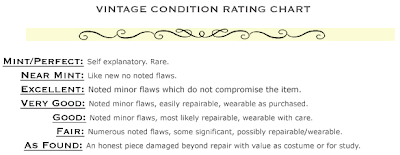Condition continued
Because there was some discussion of condition after my vintage myth busting post of last week, I was reminded that one of the Big Issues with vintage clothing has only been lightly touched upon by me. I've written several times that it is probably best for a vintage newcomer to stick with excellent condition, or the rarer mint condition. You may have seen good condition listed, or very good, and wondered what that meant. I mean, isn't good perfectly fine?
Years ago, a group of online vintage sellers worked hard to hammer out a set of words to codify condition ratings. This chart has been edited and tweaked by various groups and sellers, this is one version of it which Maggie of magsrags posted at the Vintage Fashion Guild:
Note (dare I say?) how much the word noted is in this chart...noting the flaws is a big job for a seller, but this is the only way for an online buyer to have a sense of what might be wrong. I do not use this chart in my listings, I don't actually use a chart. My own belief is that what matters is the detail of the condition, in words and pictures. I use the words Mint, Excellent, Very Good, Good and Fair, more or less as shown in this chart, and then I try to innumerate the issues.
For the beginning vintage buyer online, I stand by the need to consider condition seriously, and to stick with the top levels of condition. A bargain price on an amazing looking item may reflect serious problems. If a seller calls the condition anything less than mint or excellent and doesn't describe the flaws, ask. The seller needs to describe (and ideally also show) what keeps the item out of excellent or mint status.
I know—I have purchased from sellers who didn't adequately describe the flaws that I'm sure they saw, like gaping holes in the lining. The buyer does not need to accept really faulty condition descriptions if she receives an item not as described unless the seller specifically states that the item is as-is and there are no refunds. You have to get in the habit of reading a seller’s terms of sale. If you are looking at an item from a seller whom you trust, you may not need to question what very good means but if someone you don’t know says something is very good without explanation, I would ask for more detail. For good condition, even more so.
As I wrote in my vintage myth busting blog post, I don't really believe in the term “vintage condition.” I don't begrudge the excellent sellers who use the term, and think I understand the reason they do. However, I strongly believe that all issues have to be addressed whether they are due to the age of the garment or any other reason, so why bother adding a vague age-related factor? As an online vintage buyer (particularly thinking of the novice buyer), I believe a seller would need to say what causes an item to be in excellent vintage condition as opposed to excellent condition. Sellers, if you do use that term, I would suggest letting everyone know what you mean by it, ideally on a case-by-case basis.
To be honest, I personally wear plenty of vintage items with flaws. If you love the item and know you look and feel good in it, the flaws tend to be minor for you. It takes a little experience with vintage to know how far you are able to go with condition issues. Start with very small problems and discover your personal tolerance.
Next time: Loose ends round up









No comments:
Post a Comment